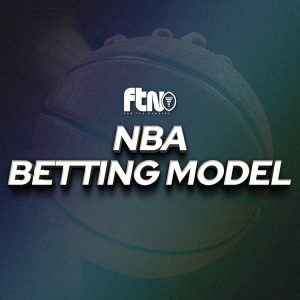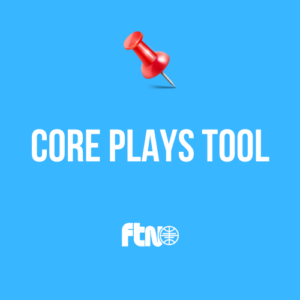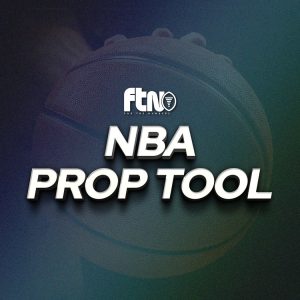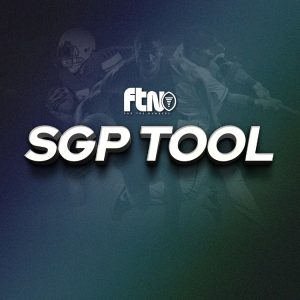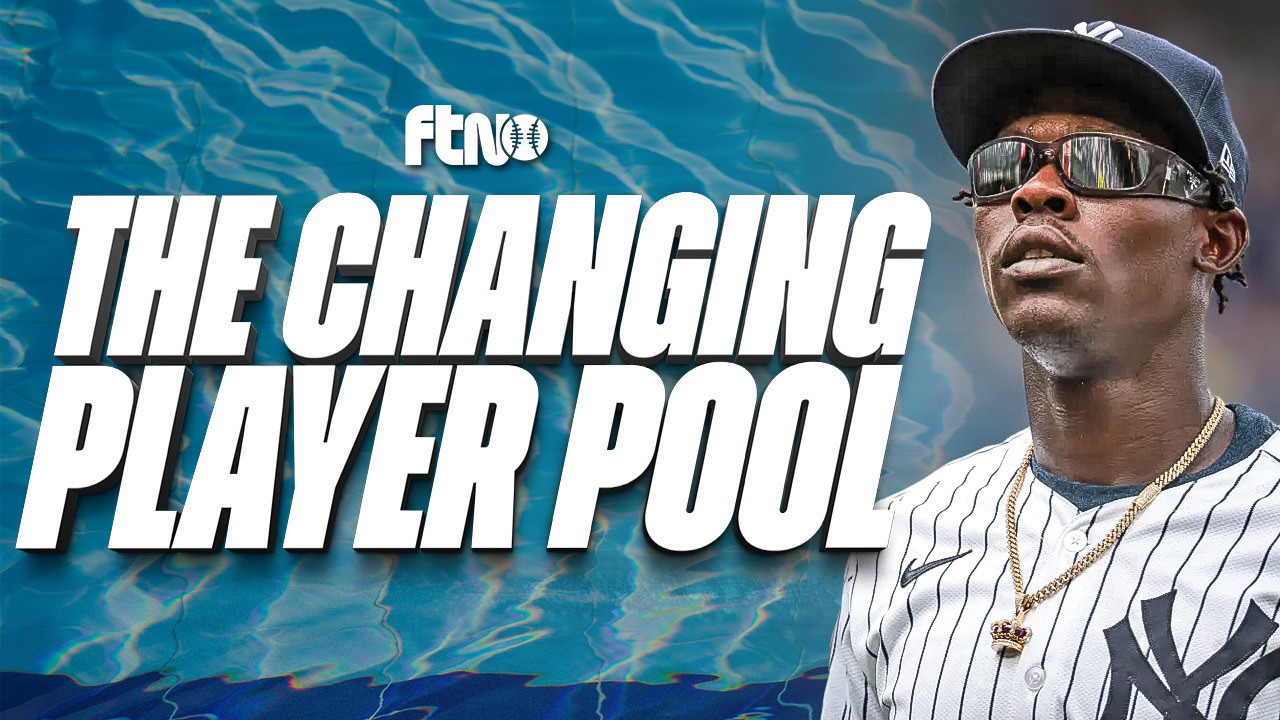
Welcome to the second and final part of my high-level 2025 player pool overview series. The goal here is to highlight the player pool differences between now and March 2024 when high-stakes contests such as the NFBC Main Event were drafted. While hopefully helpful to all fantasy baseball managers, this article is geared primarily to those already drafting for the 2025 season or are gearing up to do so. Part One of this miniseries covers the infield positions and this one focuses on outfielders, utility-only hitters, starting pitchers and relief pitchers.
Outfield
Quick Take: The position is top-heavy like shortstop and, while there are numerous options in the middle rounds, managers may find it challenging to avoid platoon players for their OF4 and OF5 slots.
Like shortstops, outfielders dominate the first few rounds of DC drafts. Like shortstops, outfield thins out noticeably as drafts reach the middle and late rounds. While there are far too many outfielders to dive deeply into individual players here, there are several things to consider when plotting how best to address the position.
First, if managers want a stud outfielder, be prepared to draft him early. Through Dec. 5, this is how the DC ADP shakes out for outfielders by tiers of 15:
| Tiers of Outfielders | DC ADP Through Dec 5 (Rounds) |
| OF1 (Outfielders 1-15) | 4 through 43 (Rounds 1-3) |
| OF2 (Outfielders 16-30) | 49 through 135 (Rounds 4-9) |
| OF3 (Outfielders 31-45) | 138 through 193 (Rounds 10-13) |
| OF4 (Outfielders 46-60) | 198 through 251 (Rounds 14-17) |
| OF5 (Outfielders 61-75) | 254 through 310 (Rounds 17-21) |
| OF6 (Outfielders 76-90) | 317 through 381 (Rounds 22-26) |
While the first 15 OF are drafted in Rounds 1-3, each successive tier of outfielders is rostered over four to six rounds. It also should be noted that the above table includes players eligible at multiple positions, some of whom will be drafted to be slotted into positions other than OF. Thus, while most managers in 30-player FAAB leagues want to roster at least six outfielders, many of the players drafted in the OF6 tier above really will be drafted as a team’s fifth outfielder.

Managers seeking an OF1 will be faced with some interesting options with their first three picks, including players coming off disappointing seasons (Corbin Carroll, Julio Rodríguez), players whose seasons were marred by injuries (Kyle Tucker [78 games], Fernando Tatis Jr. [102], Mookie Betts [116], Ronald Acuña Jr. [49] and Michael Harris II [110]), and players with only one strong fantasy season to date (Jackson Chourio, Jarren Duran and Jackson Merrill).
The OF2 tier similarly includes players with limited track records for fantasy, including James Wood, Wyatt Langford, Brenton Doyle and Lawrence Butler. While all four performed relatively well (or better) in 2024, managers must decide if any or all of this quartet warrants being selected in the top 100 picks. Like all tiers, it also includes players coming off injury-plagued and/or disappointing seasons, such as Luis Robert Jr., Randy Arozarena, Christian Yelich and Adolis García.
The OF3 tier presents managers with increased uncertainty. Will Pete Crow-Armstrong hit well enough to justify a Round 10 pick? How many games will Mike Trout play? Will Jasson Domínguez earn an everyday role for the Yankees (despite sitting in favor of a struggling Alex Verdugo in the playoffs)? How will youngsters like Dylan Crews, Colton Cowser, Parker Meadows and Ceddanne Rafaela fare over a full season? Notably, Tier 3 is the first tier that includes players – Josh Lowe and Kerry Carpenter – who profile as strong-side platoon bats.
The ”uncertainty index” ratchets up a notch in the OF4 tier. Outfielders in this tier tend to have intriguing upsides but will require managers to believe in performance that generally has not lasted. For instance:
- Do managers believe Alec Burleson will continue to compile fantasy-relevant stats on a weakened, rebuilding Cardinals team that plays its home games in a pitcher-friendly park?
- Do managers believe Cedric Mullins can recapture the magic of his 2021 season or succumb to increased playing time risk and yet another sub-.235 season?
- After years of struggling with injuries and mediocre performance, do managers believe the 2024 version of Victor Robles can carry over into 2025?
- After mediocre (or worse) performance 2012-2023, do managers believe that Jurickson Profar can continue his substantially improved 2024 performance?
- Do managers believe that Jake McCarthy has locked up — and will hold onto — a full-time outfielder position for the Diamondbacks?
- Do we believe in the 2023 version of Nolan Jones (20 HR, 20 SB, .297 AVG in 100 games) or the 2024 version (3 HR, 5 SB, .227 AVG in 79 games)?
- Will Twins manager Rocco Baldelli follow through on his plan to limit Byron Buxton to 100-110 games to help keep him healthy and productive? Is this a negative or positive for his 2025 fantasy value?
If managers think the OF4 tier reflects uncertainty, wait until they get a good look at the OF5 tier. This tier is chock full of players with limited MLB experience and players who struggled in 2024:
- George Springer (only 130 R+RBI in 145 games, .220 AVG)
- TJ Friedl (.226 AVG in only 85 games)
- Roman Anthony (0 MLB games)
- Wilyer Abreu (one full MLB season, rumored to be on trading block)
- Jung Hoo Lee (2 HR and 2 SB in only 37 MLB games)
- Matt Wallner (spent half of 2024 in minors)
- Jo Adell (power/speed combo who has hit .207 in each of last two seasons)
- Evan Carter (recurring back issues, .188 AVG in only 45 games)
- Jordan Walker (demoted for majority of 2024 season, hit .201 with 5 HR and 1 SB in 51 MLB games)
- Heston Kjerstad (6 HR, 1 SB in 52 MLB games)
- Daulton Varsho (hit .220 and .214 in 2023 and 2024, respectively, and reportedly unlikely to be ready for Opening Day)
Many of the players highlighted above in the OF5 tier will be drafted as our fourth outfielder. The position only gets thinner and more platoon-driven, beyond the top 75. Here are the two strengths of the outfielder position are:
- In FAAB, it is easiest to churn and more permanently upgrade.
- While 4-5 category studs disappear quickly, the position has plenty to offer teams hunting runs, RBI, and stolen bases, at least through the 20th round in 15-teamers.
However, fantasy managers seeking helpful batting averages or strong power with acceptable averages might be disappointed. The most important takeaway from this positional overview is this: while there plenty of viable outfielders (teams need five – and will want six or seven), they tend to go quickly in drafts, leaving us dissatisfied with our options earlier than we might expect. Risk adverse managers seeking five full-time, projectable outfielders must prioritize the position during the first half of 30-round drafts.
Utility Only
Quick Take: Compared to 2024, there are more fantasy-relevant UT-only players and several of them have a steep draft cost.

In last season’s Main Event, there were four fantasy relevant players eligible only at UT, and Shohei Ohtani was the only one who required a pick in the first 10 rounds. Those players were Ohtani (ADP: 12), Marcell Ozuna (168), Eloy Jiménez (224) and J.D. Martinez (271). Based on their prices in early DC drafts, Jimenez and Martinez are unlikely to be relevant in 30-round FAAB leagues.
This draft season, the landscape for UT-only players has changed in two material respects. First, there are many more fantasy-relevant players eligible only at UT. Second, there is a quartet of options being drafted early by managers unfazed by their lack of positionality.
Currently, Ohtani is being taken in the first three picks, and almost always first or second. Thereafter, Kyle Schwarber and Marcell Ozuna have early ADPs in the fifth round, and Brent Rooker’s ADP is near the Round 5/6 turn. While some managers dislike committing their UT slot to a single player, the 2024 performance of these players justifies their high draft cost:
| Player | HR | R | RBI | SB | AVG |
| Ohtani | 54 | 134 | 130 | 59 | .310 |
| Schwarber | 38 | 110 | 104 | 5 | .248 |
| Ozuna | 39 | 96 | 104 | 1 | .302 |
| Rooker | 39 | 82 | 112 | 11 | .293 |
After this foursome is off the board, the next group of UT-only players typically are not drafted until after Round 20. While some UT-only options will be drafted late in DC leagues, the only ones with potential FAAB relevance are Giancarlo Stanton, Joc Pederson, Kyle Manzardo and Masataka Yoshida.
Starting Pitcher
Quick Take: While there may be a perceived lack of “slam dunk” aces, the pool of strong starting pitchers feels deeper than in recent seasons.
In evaluating the changing landscape at starting pitcher compared to the last few weeks of March, when most higher stakes leagues were being drafted, it is important to recognize that, at least in the NFBC, pitching gets pushed up in the high-dollar contests. This phenomenon has taken place like clockwork for at least the last decade, if not longer. Thus, when comparing early 2025 DC leagues with contests such as last March’s Main Event, it would not be surprising to see starting pitchers drafted less aggressively. Significantly, however, that is not happening. This year’s starting pitching pool feels thinner at the very top, but deeper in terms of solid options. Early draft results support this perception.
In the 2024 Main Event, there were seven pitchers with ADPs in the first two rounds:

- Spencer Strider (ADP: 2)
- Corbin Burnes, Zack Wheeler (17)
- Luis Castillo (22)
- George Kirby (24)
- Pablo López (25)
- Tyler Glasnow (26)
In early DC drafts, the SPs drafted in the first two rounds are: Paul Skenes, Tarik Skubal, Wheeler and Logan Gilbert. While there are fewer starting pitchers at the very top in DC leagues, it is worth noting that more SPs have an ADP within the first 12 rounds (DC leagues Oct. 1-Dec. 5) than in last year’s Main Event.
| Rounds | 2024 Main Event | 2025 DC Leagues |
| 1-2 | 7 | 4 |
| 1-3 | 13 | 8 |
| 1-4 | 17 | 14 |
| 1-6 | 27 | 25 |
| 1-8 | 34 | 37 |
| 1-10 | 44 | 46 |
| 1-12 | 48 | 54 |
Another early DC trend is that managers are willing to accept innings risk in exchange for elite skills and expected production. Check out this list and you’ll know exactly what I mean:
- Paul Skenes — the highest-drafted pitcher despite only 133 career MLB innings
- Chris Sale — turning 36 at the end of March; threw 151 total innings 2021-2023
- Jacob deGrom — turning 37 in June; threw 41 total innings in the last two seasons; has not thrown more than 92 innings in a season since 2019
- Garrett Crochet — before last season’s 146 innings, had thrown 45.1 total innings across the majors and minors from 2020 through 2023
- Blake Snell — has pitched nine seasons in MLB and only has two seasons (2018 and 2023) with more than 130 innings
- Yoshinobu Yamamoto only 90 innings pitched for the Dodgers in his rookie campaign
- Gerrit Cole — will turn 35 in September, threw only 95 innings in 2024
Another change from last March’s higher stakes drafts to this season’s early DC leagues – based solely on my opinion and perceptions as an active NFBC manager (20-plus teams in recent seasons) – is that the starting pitching pool feels deeper in terms of quality options. In March, I felt pressure to aggressively draft my first three starting pitchers due to a perceived drop-off after the first 30-40 were rostered. Now, while there may not be all that many “slam dunk” aces, the pool of starting pitchers feels deeper before any perceived drop-off into mediocrity. For instance, here is a sampling of starting pitchers being drafted outside of the first 10 rounds:

- Shane Baz – 3.06 ERA/1.06 WHIP in almost 80 innings in 2024
- Ryan Pepiot – 3.57 ERA/1.15 WHIP while racking up 142 K in 130 IP
- Sandy Alcantara – former Cy Young winner should be fully recovered from TJS
- Seth Lugo – won 16 games in 2024; 3.00 ERA/1.09 WHIP over 206.2 IP
- Zach Eflin – 3.59 ERA/1.15 WHIP in 2024; 3.50 ERA/1.02 WHIP in 2023
- Sean Manaea –3.47 ERA/1.08 WHIP last season with 184 K
- Luis Gil – AL Rookie of Year; 171 K in 151.2 IP with 3.50 ERA/1.19 WHIP
- Bowden Francis – remarkable second half; finished season with 3.27 ERA/0.92 WHIP
- Brandon Woodruff – two-time all-star returning from injury
- Nathan Eovaldi – 3.80 ERA/1.11 WHIP in 2024; 3.60 ERA/1.13 WHIP in 2023
- Clarke Schmidt – having breakout season prior to injury; 2.85 ERA/1.18 WHIP
- Tanner Houck – strong 2024 season; 3.12 ERA/1.14 WHIP
- Ronel Blanco – 2.80 ERA/1.09 WHIP with 13 wins, 166 K, and one no-hitter
- José Berríos – 16 wins with 3.60 ERA/1.15 WHIP
- Jackson Jobe, Bubba Chandler, Andrew Painter, Kumar Rocker – highly touted prospects
I am sure that once Spring Training begins and starting pitcher injuries accumulate, the healthy options will be pushed up the draft board. Nevertheless, starting pitcher feels deeper throughout the pool than last season despite being slightly less represented in the first two rounds.
Relief Pitcher
Quick Take: Due to considerable uncertainty regarding many teams’ closer roles, relief pitchers viewed as “safe” closers are more aggressively targeted in early DCs.
When it comes to relief pitchers, there are three primary differences between high-stakes leagues being drafted shortly before the start of the 2024 season and DC leagues being drafted now, well in advance of the 2025 season.
- Greater “closer uncertainty” affecting teams now compared to last March (or what will exist this coming March).
- Due to this uncertainty and a smaller supply of relief pitchers perceived to be “safe” closers, those fitting that bill are being drafted aggressively in early DCs.
- Since this supply of safe closers is exhausted earlier than in 2024 Main Events, fewer relievers are being drafted in the early rounds of DC drafts.
Set forth below is a table depicting the distribution of relief pitchers in the first 12 rounds of the 2024 Main Event and 2025 DC leagues drafted through Dec. 5:
| Rounds | 2024 Main Event | 2025 DC Leagues |
| 1-2 | 0 | 0 |
| 1-4 | 4 | 8 |
| 1-6 | 13 | 11 |
| 1-8 | 17 | 11 |
| 1-10 | 22 | 15 |
| 1-12 | 25 | 18 |
A few interesting observations from the above table include:
- The 2024 Main Event and early 2025 DC leagues had and have zero relief pitchers with ADPs in the first two rounds
- In early DC leagues, eight relief pitchers currently are being drafted in Rounds 3-4, which is double the amount that, on average, were drafted in those rounds during the Main Event
- In Rounds 5-6 of early DC leagues, only three additional relievers consistently are being drafted, as compared to nine relievers with 2024 Main Event ADPs in those rounds
- Currently, zero relief pitchers have DC ADPs in Rounds 7-8, signifying a clear separation between the top 11 relievers and the remaining options

The 11 relief pitchers who managers currently are drafting aggressively in Rounds 3-6 of early DC leagues: Emmanuel Clase, Josh Hader, Devin Williams, Edwin Díaz, Mason Miller, Ryan Helsley, Félix Bautista, Raisel Iglesias, Robert Suarez, Jhoan Duran and Andrés Muñoz. These are the relievers that the market currently perceives as ”safe.” As of Dec. 5, they all have ADPs between 35 and 75.
This next trio of relief pitchers is a unique group in a tier of their own and have average draft positions three rounds after the Duran/Muñoz group is typically selected. Kirby Yates, Lucas Erceg and Ryan Walker – who had tremendous 2024 seasons where they finished as their teams’ clear-cut closer:
| Player | IP | W | SV | K | ERA | WHIP |
| Yates | 61.2 | 7 | 33 | 85 | 1.17 | 0.83 |
| Erceg | 61.2 | 2 | 14 | 72 | 3.36 | 1.05 |
| Walker | 80.0 | 10 | 10 | 99 | 1.91 | 0.85 |
Despite excellent 2024 campaigns, the early NFBC draft market perceives uncertainty as to whether Erceg and Walker will continue to close for their respective squads and whether Yates – currently a free agent – will be signed to serve as a closer for his next team or work as a setup man. The trio’s ADPs assuredly will move up or down depending on whether their claims on a closer role become more or less secure.
Reviewing how the player pool changes at each position is a helpful exercise that provides insight into the minds of early drafters. There are always opportunities to exploit misperceptions and easily identifiable market inefficiencies. Hopefully, this two-part series allows early drafters an opportunity to recalibrate from a 20,000-foot view and welcomes the 2025 newbies with a fresh perspective. So, go ahead and dive deep into the player pool by position. The water is warm.


































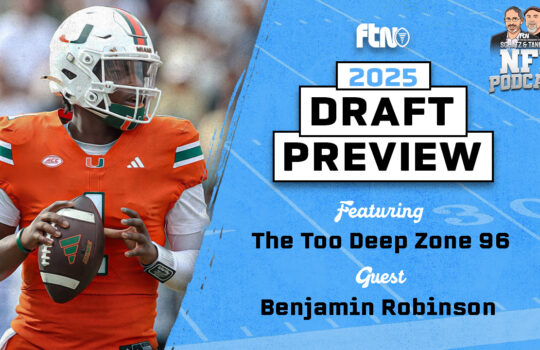




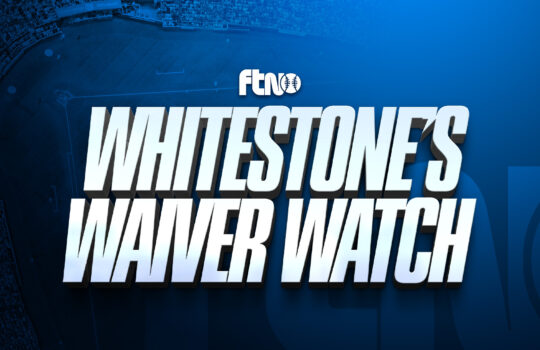

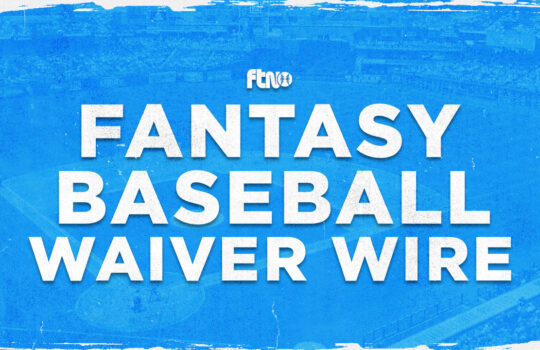

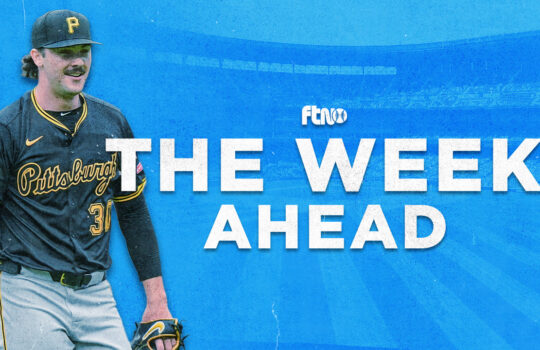

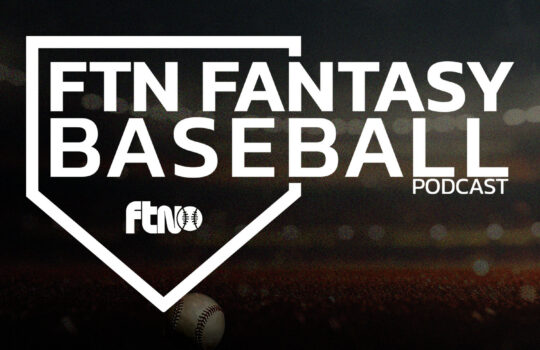

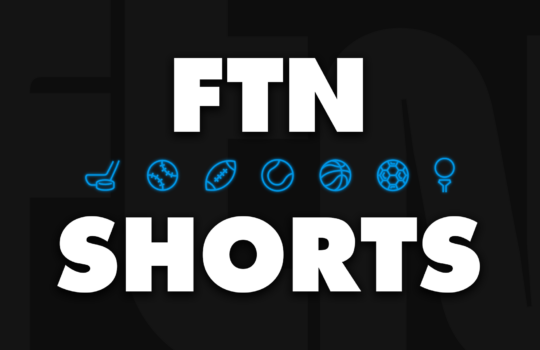
 New York Jets
New York Jets  New England Patriots
New England Patriots  Miami Dolphins
Miami Dolphins  Buffalo Bills
Buffalo Bills  Pittsburgh Steelers
Pittsburgh Steelers  Cleveland Browns
Cleveland Browns  Cincinnati Bengals
Cincinnati Bengals  Baltimore Ravens
Baltimore Ravens  Tennessee Titans
Tennessee Titans  Jacksonville Jaguars
Jacksonville Jaguars  Indianapolis Colts
Indianapolis Colts  Houston Texans
Houston Texans  Las Vegas Raiders
Las Vegas Raiders  Los Angeles Chargers
Los Angeles Chargers  Kansas City Chiefs
Kansas City Chiefs  Denver Broncos
Denver Broncos  Washington Commanders
Washington Commanders  Philadelphia Eagles
Philadelphia Eagles  New York Giants
New York Giants  Dallas Cowboys
Dallas Cowboys  Minnesota Vikings
Minnesota Vikings  Green Bay Packers
Green Bay Packers  Detroit Lions
Detroit Lions  Chicago Bears
Chicago Bears  Tampa Bay Buccaneers
Tampa Bay Buccaneers  New Orleans Saints
New Orleans Saints  Carolina Panthers
Carolina Panthers  Atlanta Falcons
Atlanta Falcons  San Francisco 49ers
San Francisco 49ers  Seattle Seahawks
Seattle Seahawks  Los Angeles Rams
Los Angeles Rams  Arizona Cardinals
Arizona Cardinals 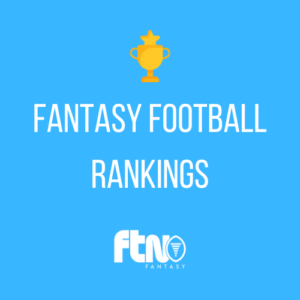
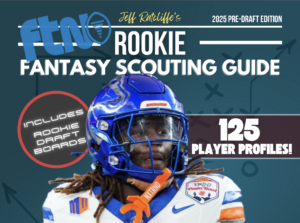
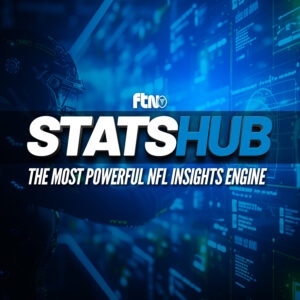
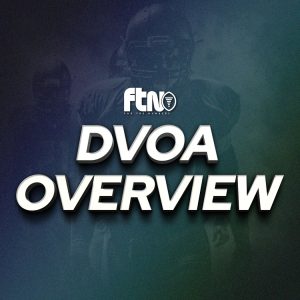
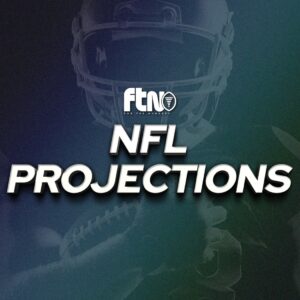


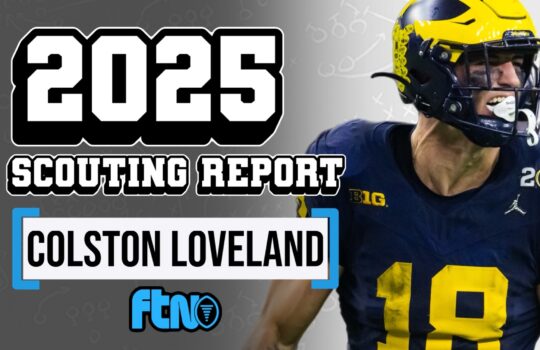


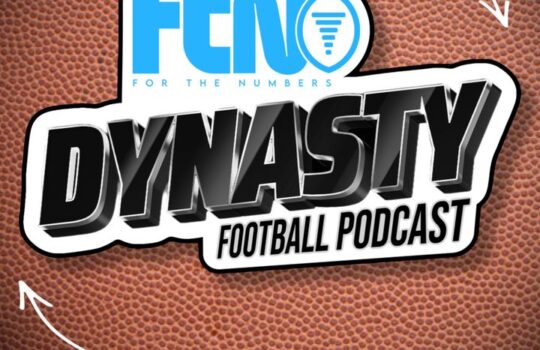
 Boston Celtics
Boston Celtics  Brooklyn Nets
Brooklyn Nets  Philadelphia 76ers
Philadelphia 76ers  New York Knicks
New York Knicks  Toronto Raptors
Toronto Raptors  Chicago Bulls
Chicago Bulls  Detroit Pistons
Detroit Pistons  Milwaukee Bucks
Milwaukee Bucks  Cleveland Cavaliers
Cleveland Cavaliers  Indiana Pacers
Indiana Pacers  Orlando Magic
Orlando Magic  Atlanta Hawks
Atlanta Hawks  Charlotte Hornets
Charlotte Hornets  Miami Heat
Miami Heat  Washington Wizards
Washington Wizards  Denver Nuggets
Denver Nuggets  Minnesota Timberwolves
Minnesota Timberwolves  Oklahoma City Thunder
Oklahoma City Thunder  Portland Trail Blazers
Portland Trail Blazers  Utah Jazz
Utah Jazz  LA Clippers
LA Clippers  Golden State Warriors
Golden State Warriors  Los Angeles Lakers
Los Angeles Lakers  Phoenix Suns
Phoenix Suns  Sacramento Kings
Sacramento Kings  Dallas Mavericks
Dallas Mavericks  Houston Rockets
Houston Rockets  Memphis Grizzlies
Memphis Grizzlies  New Orleans Pelicans
New Orleans Pelicans  San Antonio Spurs
San Antonio Spurs 

